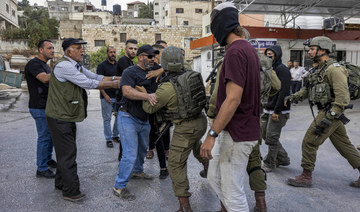RAMALLAH: Residents of four Palestinian villages in the occupied West Bank are living in fear as dozens of Israeli settlers return to rebuild a settlement that was evacuated in 2005.
Settlers are clearing land, setting up mobile caravans and building a religious school in Homesh, an outpost on the road connecting the governorates of Nablus and Jenin.
To help the settlers, the Israeli army has stepped up mobile and foot patrols, placed cement blocks on the main road, and built military observation towers.
Eyewitnesses said settlers destroyed Palestinians’ crops and troops detained Palestinian farmers while work at the settlement continued.
The rebuilding work follows an Israeli government decision in March to allow Israelis to resettle four illegal settlements in the northern occupied West Bank, including Homesh.
Palestinians see the rebuilding of Homesh, which is located deep in the northern West Bank, as a severe blow to plans to establish a future Palestinian state.
Saeed Abdel Rahim, a Palestinian activist from the village of Burqa, near Homesh, said that buses, caravans and other heavy vehicles were being used to transport building equipment for houses, while the settlement’s surroundings have been transformed into military barracks, reinforced by the army and guards.

Israeli settlers installing a portable building at the former settler outpost of Homesh in the occupied West Bank on May 29, 2023. (Photo by Menahem Kahana / AFP)
Homesh was one of the four settlements evacuated in 2005 as part of a “disengagement” plan.
Israeli sources said the government has laid out plans to absorb half a million new settlers in the West Bank, and to improve infrastructure in settlements and outposts.
Ghassan Daghlas, a Burqa resident who is in charge of the settlement file at the Palestinian presidency, told Arab News that the latest development is a catastrophe in light of settlers’ plans to build what is called “Homesh Al-Kubra.”
Settlers have installed at least 30 housing units in the past few days and begun building infrastructure, he said.
The return of the Homesh settlement will affect at least 34,000 Palestinians who live in the villages of Burqa, Wasila Al-Zahr, Bazariya, Sebastia and other nearby towns, Daghlas added.
He said that returning settlers have been given political cover by Israel’s extreme right-wing government, “which only thinks of strengthening settlements and seizing more land.”
However, Daghlas added: “We will continue blocking their way through popular resistance until this project is thwarted.”
Work on Homesh means “more checkpoints and restrictions on the Palestinians in the area, and more soldiers turning the area into a military base. We are heading toward violence,” he said.
During a visit to Burqa on Saturday, Majdi Al-Saleh, a Palestinian government minister, was urged by village representatives to provide substantial assistance and not be content with media statements.
A resident told Arab News that Israeli intelligence officers were calling on activists to calm down after young men set up WhatsApp groups with 1,400 active members to alert each other in the event of any settler or army attack.
The Palestinian presidency said that all settlements built on Palestinian land, including Homesh, are illegal and condemned the decision to allow settlers to return.
The move is part of a “quiet annexation” of the occupied West Bank under the supervision and support of the Israeli government, it added.
Israel’s left-wing Peace Now movement said the rebuilding of the Homesh settlement violated international law and Israel’s commitment to the US.
Israel signed an agreement with President George Bush’s administration to refrain from building new settlements in areas vacated during the 2005 disengagement.
The movement said on its website that more than 465,000 settlers live in 132 settlements and 146 random outposts established on the West Bank.
These numbers do not include 230,000 settlers living in 14 settlements in East Jerusalem, it added.
Peace Now warned that the Israeli government would confiscate private Palestinian land in the public interest, but use them for settlements.
The Homesh settlement was established in 1978 as an Israeli military base on land owned by Palestinians from the neighboring villages of Burqa and Silat Al-Dhahr.
In 1980, the Israeli army handed over the base to settlers, as happened with several other settlements in the West Bank.
Ziyad Abu Omar, head of the local council in Burqa, said the resettlement of Homesh means the “destruction of Burqa and other surrounding villages.”



























